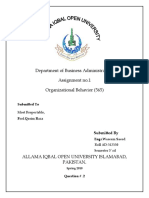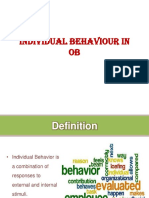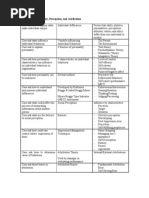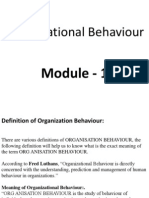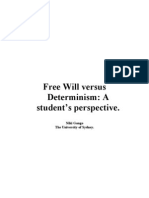Module II Individual Behaviour
Uploaded by
Ayush PatelModule II Individual Behaviour
Uploaded by
Ayush Patel1
Module II: Individual Behaviour
Individual Differences - All organizations are composed of individuals. No organization can exist
without individuals. Human behavior, which is; considered a complex phenomenon, is very
difficult to define in absolute terms. It is primarily a combination of responses to external and
internal stimuli. These responses would reflect psychological structure of the person and may be
results ‘of the combination of biological and psychological processes, which interpret them,
respond to them in an appropriate manner and learn from the result of these responses.
An individual makes a variety of contributions to an organization in the form of
efforts, skills, ability, time, loyalty and so forth. These contributions presumably satisfy various
needs and requirements of the organization. In return for contributions, the organization provides
incentives such as pay, promotion, and job security to the employee. Just as the contributions
available from the individual must satisfy the organization's needs, the incentives must serve the
employees' needs in return.
If both the individual and the organization consider the psychological contract fair and equitable,
they will be satisfied with the relationship and are likely to continue it. If either party perceives an
imbalance or iniquity in the contract, it may initiate a change. A major challenge faced by an
organization, thus, is to manage the psychological contracts. One specific aspect of managing
psychological contracts is managing the person-job fit. The 'person-job fit' is the extent to which
the contributions made by the individual match the incentives offered by the organization. The
behavior of individuals in organization is the primary concern of management and it is essential
that the managers should understand the factors influencing the behavior of the employees they
manage. The figure 5.1 identifies five sets of factors that have an impact upon individual behavior
in organizations.
Important dimensions of individual differences
Self-concept
Personality dimensions
Abilities, and
Personal values and ethics.
Self-concept -Self is the core of one's conscious existence. Awareness of self is referred to as one's
self-concept. Sociologists Viktor Gecas defines self-concept as "the concept the individual has of
himself as a physical, social and spiritual or moral being". In other words, every individual
recognizes himself as a distinct individual. A self-concept would be impossible without the
capacity to think. This brings us to the role of cognitions. Cognitions represent, "any knowledge,
opinion, or belief about the environment about oneself, or about one's behavior". Among many
different types of cognitions, those involving expectation, planning, goal setting, evaluating and
setting personal standards are particularly relevant to organizational, behavior.
Made by Ujjwal Sharma
2
Self-esteem -Self-esteem is a belief over one's own worth based on an overall self-evaluation.
Those with low self- esteem tend to view themselves in negative terms. They do not feel good
about themselves, tend to have trouble in dealing effectively with others, and are hampered by
self-doubts. High self-esteem individuals, in contrast, see themselves as worthwhile, capable and
acceptable. Although, high self-esteem is generally considered a positive trait because it is
associated with better performance and greater satisfaction, recent research uncovered flaws
among those having high self-esteem. Specifically, high self-esteem subjects tended to become
self-centered and boastful when faced with situations under pressure Hence moderate self-esteem
is desirable.
Managers can build employee self-esteem in four ways:
1. Be supportive by showing concern for personal problems, interests, status and contribution.
2.Offer work involving variety, autonomy and challenges that suit the individual’s values, skills
and abilities.
3.Strive for management-employee cohesiveness and trust building.
4.Have faith in each employee's self-management ability, reward successes.
Self-efficacy - Self-efficacy is a person's belief about his' or her chances of successfully
accomplishing a specific task. According to one organizational behavior writer, "Self-efficacy
arises from the gradual acquisition of complex, cognitive, social, linguistic, and/or physical
skills through experience", There is strong linkage between high self-efficacy expectations and
success in term of physical and mental tasks, anxiety reduction, addiction control, pain tolerance
and illness recovery. Oppositely, those with low self-efficacy expectations tend to have low
success rates.
Factors affecting Individual Difference - Every individual is different from each other, as the
behavior of the human is considered as the most complex one. There are various challenges in an
effective organization that could directly or indirectly affect the behavior of the employees. In
certain situations, the manager of the organization has to first analyze the particular task, determine
the skills required and gather a team that could complement and match the skills of each other. For
addressing various factors, safety settings, capabilities of people and limitations have to be
analyzed first. There are various factors that could affect the organizational behavior of an
individual, some of them are:
A. Personal factors – The personal factors that can influence the behavior of an individual is
further categorized into 2 parts that includes Biographic and learned characteristics.
1. Biographic Characteristics – Every human being has certain type of characteristics which are
inherited and genetic in nature. These characteristics cannot get changed. In an organization, if the
manger will come to know about the limitations and qualities each personal possess, then they can
easily make use of their behavior techniques of an organization in an effective manner. These
characteristics include:
(i) Physical Characteristics – It mainly consists of skin, vision, height, complexion and many more.
It creates impact on the performance of the individuals. Also, certain features includes tall, fat or
Made by Ujjwal Sharma
3
slim. A person with good personality is always expected to dress and behave well in an
organization, even if there is any correlation between the behavior and body structure or not.
1. Age – It is the inherited characteristic of an individual. In increasing performance, it is
considered as an issue. Young people are expected to behave more energetic, adventurous,
innovative, risk taking and ambitious. With the advancement in age, performance of a person is
more likely to decline.
2. Gender – It is a genetical feature. This concept has initiated lots of discussion, debates and
opinions. It is a traditional view that women are more emotional. A small difference between men
and women can affect their job performance. Without any male-female differences, some of the
people have competitive drive, leadership, motivation, learning ability, analytical skills or
problem-solving ability. A study has been conducted which says that the female employees
generate more turnover rates. This is because there are more chances of females to quit their job
for their personal reasons.
difference between men and women can affect their job performance3. Religion – In determining
some of the aspects of individual behavior, religion and its related cultures plays a significant role
especially that have the basic concern with ethics, morals and code of conduct. It also helps in
identifying the attitude of an individual towards their work and financial management incentives.
But nobody can deny from the fact that people who are highly religious have more moral values
than others.
4. Marital Status – A recent research says that the responsibilities of the person inclined with their
marital status and it has become difficult to s6table in a particular job for the longer period of time.
Employees that are married have fewer absences, more job satisfaction and fewer turnovers.
5. Experience – The tenure or the experience of an employee plays a significant role within the
organization. It creates lot of speculations and misconceptions due to the seniority factor. Also,
work experience is considered as a good indicator that helps in increasing productivity with greater
efficiency and effectiveness. There is a positive relationship between the job performance and the
seniority. The turnover of an employee is also considered as negative in relation to the seniority.
2. Learned Characteristics – Learning is defined as a permanent change in the behavior of an
employee that results in the interactions with the environment. The biographical features of a
person are impossible to modify. Therefore, the managers of the organization paid a great interest
in learning, studying and predicting the learned characteristics that include:
(1) Personality – Personality does not only lie with the physical appearance of the person. A person
with a good personality comprised of smart person, smiling face and charming personality. This
concept is considered as dynamic that describes the growth and development of the psychological
system of the person. It is also refereed as personal traits or characteristics that include persistence,
dominance, aggressiveness and other qualities that is reflected through the behavior of the person
within the organization.
Made by Ujjwal Sharma
4
(2) Perception – It is the viewpoint that helps in the interpretation of some situation. Also, it is
considered as the process which allows the information to enter in the minds and allowed to obtain
sensible meaning for the whole world.
(3) Values – Values are considered as the global belief that instructs different judgments and
actions across various situations. It consists of an individual’s idea based on the right, good and
desirable opinions. It is closely embedded in the people who could be reflected through their
behavior. Also, most of time values are directly influenced from the teachers, parents, friends and
various other external factors that completely changed the ideas, opinions and thoughts of the
person. For an organizational behavior, values are very significant. It helps in understanding the
motivation and the attitude of an individual along with the influences of their perceptions or view
point.
B. Environmental Factors – On the behavior of a person, the external environment plays a
significant role.
1. Economic Factors – In an economic environment, the behavior of an individual is largely
affected due to certain factors including:
(a)Employment Level – The employment opportunities available to an individual directly
influence the behavior of an individual. Even after the lack of job satisfaction, the individual have
to stick to the same job as there are less job opportunities for him/her. In such cases, it is important
that they may be loyal to the company in providing better productivity; they are only remaining in
the same organization due to the monetary benefits offered to them.
Employment Level (b)Wage Rates – Every employee is majorly concern with the wages offered
to them by the company or the organization. The decision of a worker or an employee is directly
affected by the monetary terms from the side of the company.
(c)General Economic Environment – There are various employees that does not have any effect of
economic cycle whether in a public sector undertakings or government offices. Regardless of their
economic position within the organization, they will receive their salaries. Employees in the
private sectors are greatly affected by the stable income and job security but the former employees
can be motivated from other factors.
Similarly, there are various other environmental factors in an organization that could affect the
behavior of the employees, including social factors, political factors or legal environment.
C. Organizational Factors – With wide variety of resources and organizational systems,
individual behavior is influenced that includes:
1. Physical Facilities – At a workplace, the physical environment is considered as an arrangement
of people and things positive that could also create influence on other people. There are certain
factors that influence the behavior of an individual including cleanliness, light, ventilation, noise
level, nature of job, number of people working, etc.
Made by Ujjwal Sharma
5
(a)Structure and Design – The way in which every department of the organization is set-up has
direct concern with the structure and design. The performance and the behavior of an individual is
directly influenced by the position at which person could perfectly fits in the whole organizational
hierarchy.
(b)Leadership – The management of the organization establish the system of leadership so that the
proper assistance, advice, guidance, direction and coaching could be given to the individuals. The
behavior of each employee is influenced to the large extent to the behavior of the leaders or the
superiors of the same organization. The behavior of the leaders is more important than the qualities
of the leaders.
(c)Reward System – The performance and the behavior of individuals are directly influenced by
the reward system that is established by the organization so that the employees could be able to
compensate.
Personality - Personality refers to the unique set of characteristics, behaviors, emotions, and
thought patterns that define how a person interacts with the world and others. It encompasses
consistent patterns in how individuals perceive, feel, think, and act across different situations and
over time.
Key Aspects of Personality:
1. Traits: Stable characteristics that influence behavior. Examples include extroversion,
openness, conscientiousness, and agreeableness.
2. Temperament: Innate aspects of personality that are present from early life, such as
emotional reactivity and energy levels.
3. Cognition: How a person processes information, makes decisions, and solves problems.
4. Emotions: Patterns of feeling and emotional regulation.
5. Behavior: Observable actions and habits shaped by personality traits and environmental
influences.
Theories of Personality
1. Trait Theory: Focuses on identifying and measuring specific traits. The Big Five
Personality Traits (OCEAN) model is a well-known framework:
o Openness to Experience
o Conscientiousness
o Extraversion
o Agreeableness
o Neuroticism
2. Psychoanalytic Theory: Sigmund Freud's approach emphasizing unconscious motivations
and early childhood experiences.
3. Humanistic Theory: Focuses on individual growth, self-actualization, and free will, as
discussed by Carl Rogers and Abraham Maslow.
4. Social-Cognitive Theory: Examines how social interactions and cognitive processes shape
personality (e.g., Albert Bandura's concept of reciprocal determinism).
5. Biological Theories: Investigate the genetic and neurological basis of personality.
Made by Ujjwal Sharma
6
Factors affecting Personality – The concept of personality is studied in psychology to understand
individual differences, predict behaviors, and help in areas like mental health, career guidance, and
personal development. It is shaped by a complex interplay of biological, psychological, and
environmental factors. Here are the key factors that influence personality development:
1. Biological Factors
Genetics: Personality traits have a genetic component, with heredity playing a significant
role in traits like temperament, emotional reactivity, and extraversion.
Brain Structure and Function: The functioning of the brain, including neurotransmitter
systems (e.g., dopamine, serotonin), impacts personality traits such as impulsivity and
mood regulation.
Hormones: Hormonal levels (e.g., cortisol, testosterone) can influence behavior, mood, and
personality characteristics.
2. Environmental Factors
Family and Parenting Style: The type of upbringing, attachment style, and parental
behavior strongly shape personality. For example:
Authoritative parenting fosters independence and confidence.
Overprotective or neglectful parenting may lead to insecurity or anxiety.
Cultural Influences: Societal norms, values, and expectations impact how individuals
express personality traits.
Collectivist cultures may encourage traits like agreeableness and interdependence.
Individualistic cultures may promote self-expression and autonomy.
Peer Influence: Friends and social interactions play a critical role in shaping behavior and
attitudes, particularly during adolescence.
Educational Experiences: Exposure to different ideas, problem-solving tasks, and
mentorship in school settings shapes cognitive and emotional development.
3. Psychological Factors
Early Experiences: Childhood trauma, stress, or positive reinforcement can leave lasting
impressions on personality.
Cognitive Development: How individuals perceive the world, process emotions, and solve
problems influences their personality.
Self-Concept: The way people see themselves, including self-esteem and self-worth,
shapes their personality over time.
4. Situational Factors
Life Events: Significant events, such as marriage, job loss, or travel, can alter personality
traits, sometimes even permanently.
Social Roles: Roles like being a parent, teacher, or leader require specific behaviors and
may mold personality.
Made by Ujjwal Sharma
7
Stress and Coping Mechanisms: Prolonged stress or the strategies used to handle
challenges can reshape aspects of one's personality.
5. Cultural and Socioeconomic Factors
Cultural Norms: Cultures differ in the emphasis placed on traits such as independence,
humility, or assertiveness.
Socioeconomic Status (SES): Access to resources, education, and opportunities influences
confidence, risk-taking, and personal growth.
6. Biological and Psychological Interactions
Temperament: Inborn traits, such as being easygoing or irritable, interact with the
environment to influence personality.
Nature vs. Nurture: Personality development results from the ongoing interaction between
genetic predispositions and environmental influences.
Understanding these factors highlights how dynamic and multifaceted personality
development is, with no single factor acting in isolation.
Learning and Reinforcement (Organizational Behaviour and Design) - It is a principal
motivation for many employees to stay in organizations. Learning has a major impact on individual
behaviour as it influences abilities, role perceptions and motivation. Along with its role in
individual behaviour, learning is necessary for knowledge management. Knowledge management
improves an organization's capacity to obtain, share and use knowledge in order to improve its
operations and success.
Concept of Learning
Learning is a permanent change in behaviour due to experience or training. Learning is understood
as the adaptation of behaviour through practice, training, or experience.
According to Carl Rogers (1983), learning is a powerful encouragement for many employees to
stay in certain organizations. Learning has a major impact on individual behaviour as it influences
abilities, role perceptions and motivation.
Along with its role in individual behaviour, learning is necessary for knowledge
management. Knowledge management enhances an organization's capacity to acquire,
share and utilize knowledge for success. There are five important components of learning.
Learning involves change that may be for good or bad.
Change may not be evident until a situation arises in which the new behaviour can occur.
Learning is not always reflected in performance. Second component of learning is that not
all changes reproduce learning. To constitute learning, change should be comparatively
permanent. Temporary changes may be only reflective and fail to represent any learning.
This requirement rules out behavioural changes caused by fatigue or drugs. Thirdly,
learning is reflected in behaviour that is a change in an individual's thought process or
attitude, not accompanied by behaviour. Learning needs to result in behaviour potentiality
and not necessarily in the behaviour itself.
Made by Ujjwal Sharma
8
The reason for this difference is that an individual may learn but owing to lack of
motivation, may not show any changed behaviour. The change in behaviour should take
place as a result of experience, practice or training. This implies that behaviour caused from
maturity, disease, or physical damages do not constitute learning.
Theoretical Framework of Learning - There are four theories which give details about the
process of learning. They are Classical conditioning, Operant conditioning, Cognitive theory and
Social learning theory.
Classical conditioning - Classical conditioning is based on the principle that a physical event
referred as a stimulus that originally does not elicit a particular response and gradually acquires
the capacity to elicit that response as a result of repeated pairing with a stimulus that elicits a
reaction.
Operant conditioning - Operant conditioning also known as instrumental conditioning denotes to
the process that people's behaviour produces certain consequences. If actions of people have
pleasant effects, then they will be more likely to repeat them in the future. If, however, their actions
have unpleasant effects, they are less likely to repeat them in the future. Therefore, this theory
showed that behaviour is the function of its consequences. The well-known Skinner box verified
operant conditioning by placing a rat in a box in which the pressing of a small bar produces food.
Skinner displayed that the rat eventually learns to press the bar regularly in order to obtain food.
Made by Ujjwal Sharma
9
Besides reinforcement, punishment produces avoidance behaviour, which appears to weaken
learning but not curtail it. In both types of conditioning, stimulus generalization occurs that is the
conditioned response may be elicited by stimuli similar to the original conditioned stimulus but
not used in the original training. Stimulus generalization has huge practical significance, because
it allows for the application of learned behaviour across different contexts. Behaviour alteration is
a type of treatment resulting from these stimulus/response models of learning. It operates under
the assumption that if behaviour can be learned, it can also be unlearned Operant conditioning
emphasizes voluntary behaviour.
Cognitive theory - Cognitive theory of learning presupposes that the human being learns the
significance of various objects and event and learned responses depending on the meaning
assigned to stimuli. The cognitive theory of learning is applicable in the modern managerial
practices. Many motivation theories center on the concept of cognition. Expectations, attributions
and locus of control are all cognitive concepts requiring attention while encouraging workers.
Social learning theory: This theory is also referred as observational learning, social learning
theory, highlights the capability of an individual to learn by observing others. A great deal of what
is learned about how to behave in organizations can be explained as the result of the process of
observational learning. A new hire obtains job skills by observing what an experienced employee
does. Observational learning also occurs in a very informal and in unarticulated manner.
It is concluded that learning in organization draws more appeal from the assumption that
organizations are capable of intelligent behaviour, and that learning is an instrument for
intelligence, though sometimes an attractively unreliable one. The basic image is that organizations
collect experiences, draw inferences, and encode inferences in repositories of organizational
knowledge, such as formal rules and informal practices.
Reinforcement - Reinforcement is a process to develop or strengthen pleasing behaviour.
Reinforcement hypothesis is the method of shaping behaviour by controlling the consequences of
the behaviour. In reinforcement theory a combination of rewards and/or punishments is used to
strengthen desired behaviour or put out unwanted behaviour. Any behaviour that elicits a
consequence is called operant behaviour, because the individual operates on his or her
environment. Reinforcement theory focuses on the relationship between the operant behaviour and
the related consequences, and is also called as operant conditioning. Major contributor of this
theory was B.F. Skinner who developed modern ideas about reinforcement theory. Skinner argued
that the internal needs and drives of individuals can be ignored because people learn to exhibit
certain behaviors based on what happens to them as a result of their behaviour. Management team
must always try to shape employee behaviour to get better contributions to the company. This can
involve supporting positive behaviour or reducing negative behaviour.
Positive reinforcement - Positive reinforcement strengthens and enhances behaviour by the
presentation of positive reinforcers. There are primary reinforcers and secondary reinforcers.
Primary reinforcers satisfy basic biological needs and include food and water. However, primary
reinforcers do not always reinforce. For instance, food may not be a reinforcer to someone who
has just completed a five-course meal.
Made by Ujjwal Sharma
10
Most behaviour in organizations are influenced by secondary reinforcers. These include
benefits in organizational set up.
Positive reinforcement defines and communicates expected behaviour and strengthens the
connection between high performance and rewards.
It reinforces an employee's behaviour immediately after learning a new technique and
promotes quick, thorough learning.
It motivates effective workers to continue to do good work. Lack of reinforcement leads to
job dissatisfaction.
It increases productivity by rewarding workers who conserve time and materials.
Employees who are rewarded after they successfully perform feel self-confident and
become eager to learn new techniques, take advanced training, and accept more
responsibility.
Rewarding employees who suggest improved work procedures will produce more
innovation, it creates a relaxed work environment, reward new ideas and tolerate
innovative failures.
Negative reinforcement - In negative reinforcement, a disagreeable event that precedes a
behaviour is removed when the desired behaviour occurs. This process increases the likelihood
that the desired behaviour will occur. Just as there are positive reinforcers, there are the stimuli
that strengthen responses that permit an organism to avoid or escape from their presence. Some
negative reinforcers such as intense heat, extreme cold, or electric shock, exert their effects the
first time they are encountered, whereas others acquire their impact through repeated association.
Punishment: Punishment is an undesirable outcome a worker receives for bad behaviour. This
can involve actions such as demoting the employee or suspending the employee. A manager may
put an employee on trial pending a change in behaviour. Additionally, the employee may lose
overtime privileges or consideration for raises.
Extinction: Extinction is the elimination of a behaviour. This type of behaviour modification
should be reserved for the most damaging behaviour. When individual want an immediate and
complete stop to unwanted actions, such as smoking on the job or using sexual innuendo, offer the
most severe punishment, such as firing, if person see any more of the behaviour. Managers should
make the consequences clear and make sure employees know there will be zero tolerance.
Made by Ujjwal Sharma
11
Values - Values in personality refer to the principles, beliefs, and standards that guide an
individual's behavior, decision-making, and interactions with others. They represent deeply held
ideals that influence personal priorities and are central to defining one's character. Values often
shape and reflect an individual's personality traits, providing insight into their motivations and
worldview.
Core Values in Personality
1. Integrity: Adherence to moral and ethical principles; being honest and consistent in actions.
2. Compassion: Concern for others’ well-being, often reflected in empathy and kindness.
3. Respect: Valuing others' opinions, rights, and dignity.
4. Responsibility: A sense of accountability for one’s actions and duties.
5. Independence: Valuing autonomy and self-reliance.
6. Fairness: Commitment to justice, equity, and impartiality.
7. Loyalty: Dedication and faithfulness to people, organizations, or ideals.
8. Ambition: A drive for achievement, success, or personal growth.
9. Gratitude: Appreciation for life’s experiences and the contributions of others.
10. Open-mindedness: Willingness to consider new ideas, perspectives, and experiences.
How Values Relate to Personality
Alignment with Traits: Values often complement personality traits. For example:
o A person high in agreeableness may prioritize compassion and fairness.
o Someone high in conscientiousness might value responsibility and integrity.
Motivational Drivers: Values act as internal motivators that guide goals and actions.
Cultural Influence: Cultural background shapes which values are prioritized (e.g.,
individualism vs. collectivism).
Dynamic Nature: Values can evolve over time based on life experiences, education, or
significant events.
Values serve as a foundation for personality, influencing how individuals interpret situations,
make decisions, and build relationships, ultimately shaping the course of their lives.
Made by Ujjwal Sharma
You might also like
- TeachingStrategiesObjectiveChecklist PDFNo ratings yetTeachingStrategiesObjectiveChecklist PDF4 pages
- INDIVIDUAL BEHAVIOUR - Personality, Perception, Learning0% (1)INDIVIDUAL BEHAVIOUR - Personality, Perception, Learning17 pages
- FOUNDATION OF INDIVIDUAL BEHAVIOUR3 OriginalNo ratings yetFOUNDATION OF INDIVIDUAL BEHAVIOUR3 Original21 pages
- Individual Behaviour: By:-Ajay Kumar Assistant Professor Management Department PCTE Group of InstitutesNo ratings yetIndividual Behaviour: By:-Ajay Kumar Assistant Professor Management Department PCTE Group of Institutes14 pages
- Unit-2 Foundations of Individual BehaviorNo ratings yetUnit-2 Foundations of Individual Behavior8 pages
- Foundations of Individual Behavior FinalNo ratings yetFoundations of Individual Behavior Final37 pages
- Factors of Individual Behavior in An Organization and Its Performance at WorkNo ratings yetFactors of Individual Behavior in An Organization and Its Performance at Work6 pages
- Understanding Human Behaviour As An Essential Tool For Organisational SuccessNo ratings yetUnderstanding Human Behaviour As An Essential Tool For Organisational Success22 pages
- Chapter-2: 2.1. Concept of Individual BehaviourNo ratings yetChapter-2: 2.1. Concept of Individual Behaviour56 pages
- Individual Differences and Environmental Factors Influence Human Behavior PsychologyNo ratings yetIndividual Differences and Environmental Factors Influence Human Behavior Psychology6 pages
- Ch3 - Personality, Perception and Attribution FinNo ratings yetCh3 - Personality, Perception and Attribution Fin11 pages
- Individual and Group Behaviour in An OrganizationNo ratings yetIndividual and Group Behaviour in An Organization8 pages
- Chapter - Iv Conceptual Background On Customers PerceptionNo ratings yetChapter - Iv Conceptual Background On Customers Perception27 pages
- Why Fearful Avoidants Break Up: Understanding The Underlying Reasons 125298No ratings yetWhy Fearful Avoidants Break Up: Understanding The Underlying Reasons 1252982 pages
- Factors Influencing Consumer Behavior12No ratings yetFactors Influencing Consumer Behavior1214 pages
- PSY330 - Interview Simulation Exercise (B1900964)No ratings yetPSY330 - Interview Simulation Exercise (B1900964)12 pages
- Phototherapy As The Tool of Emotional Identification Development of AdolescentsNo ratings yetPhototherapy As The Tool of Emotional Identification Development of Adolescents10 pages
- INDIVIDUAL BEHAVIOUR - Personality, Perception, LearningINDIVIDUAL BEHAVIOUR - Personality, Perception, Learning
- Individual Behaviour: By:-Ajay Kumar Assistant Professor Management Department PCTE Group of InstitutesIndividual Behaviour: By:-Ajay Kumar Assistant Professor Management Department PCTE Group of Institutes
- Factors of Individual Behavior in An Organization and Its Performance at WorkFactors of Individual Behavior in An Organization and Its Performance at Work
- Understanding Human Behaviour As An Essential Tool For Organisational SuccessUnderstanding Human Behaviour As An Essential Tool For Organisational Success
- Individual Differences and Environmental Factors Influence Human Behavior PsychologyIndividual Differences and Environmental Factors Influence Human Behavior Psychology
- Understanding Human Behaviour in The WorkplaceFrom EverandUnderstanding Human Behaviour in The Workplace
- Chapter - Iv Conceptual Background On Customers PerceptionChapter - Iv Conceptual Background On Customers Perception
- Why Fearful Avoidants Break Up: Understanding The Underlying Reasons 125298Why Fearful Avoidants Break Up: Understanding The Underlying Reasons 125298
- Phototherapy As The Tool of Emotional Identification Development of AdolescentsPhototherapy As The Tool of Emotional Identification Development of Adolescents






